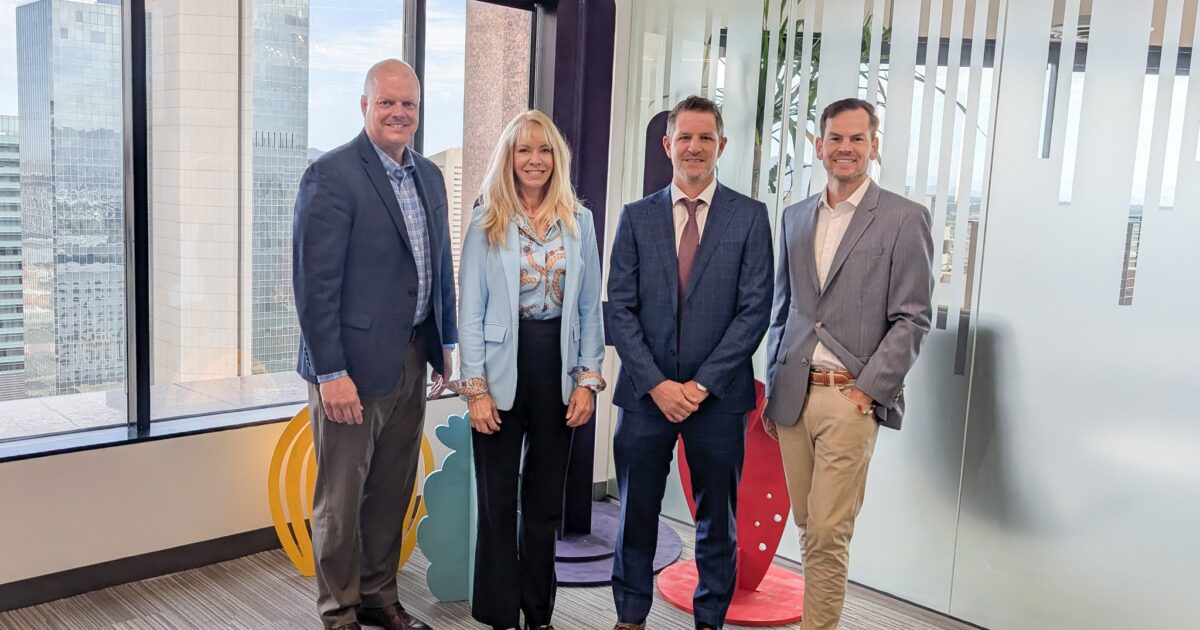

Ambassador Event: The Future of Aerospace & Defense
Published: 08/29/2024
Updated: 08/30/2024
Industry experts explored the legacy of aerospace and defense in Greater Phoenix and strategies to ensure the sector’s future growth
Greater Phoenix and Arizona have long been at the forefront of the U.S. aerospace and defense (A&D) industry due to strategic positioning, impactful military presence, a robust natural resource base and sizable private employers that have maintained the competitiveness of the region.
In July, GPEC engaged regional A&D experts in a roundtable to discuss the strengths and future opportunities within the sector and created a five-page industry report based on the conversation and recent regional data. On Aug. 27, GPEC hosted its inaugural Industry Series event focused on the future of A&D in Greater Phoenix featuring a moderated panel discussion. The panel included:
- Taylor Alberstadt, Senior Director, Sales & Marketing, Honeywell
- Angela Aspito, Managing Director, Southwest Mission Acceleration Center (opening remarks)
- Marti McCurdy, CEO, Spirit Electronics
- Ken Robinson, Attack Helicopter Program Integration Officer & Deputy Program Manager, The Boeing Company
- Chris Camacho, President & CEO, GPEC (moderator)
Responding to a call-to-action for national security
In 2022, The Department of Defense (DoD) identified 14 critical A&D-related technology areas vital to maintaining U.S. national security. Having experience running a program for the Pentagon designed to accelerate technology transition in accordance with DoD, Aspito spoke about the emerging policy changes in the defense industrial base and the expansion of funding for research and development for emerging technology in the DoD-identified areas.
“We're investing nearly $1 billion in FY25 funding on scaled manufacturing for low-cost, attritable autonomous systems,” said Aspito. “Recently, a congressional commission on the national defense strategy highlighted the stark reality we're facing, and I quote, ’The security and well-being of the U.S. are at greater risk now than any time in decades before.’ To me, this is not a cautionary statement. This is a call to action and at every level the DoD is responding to that call”.
Arizona’s strategic position
Arizona has long been established as a major A&D hub with the industry tracing back to the mid-20th century which has created the bedrock for sector growth today. “Our market is well positioned to take advantage of how DoD is thinking differently about what they invest their resources in,” said Camacho. “We’ve anchored ourselves as being a top-ten defense market in the U.S. for DoD spending.”
The industry’s gross regional product (GRP) is more than $8 billion – a 28% increase over the last five years representing nearly 4% of the region’s GRP. Additionally, Arizona is home to more than 66,000 aerospace and defense industry employees and the top five companies in the region employ nearly 20,000 people, reflecting tremendous economic diversity and growth, Camacho said.
Read more from The Future of Aerospace & Defense Industry Overview report
The region also houses major military base installations, including Fort Huachuca, Luke Air Force Base and Marine Corps Air Station Yuma. Winning future missions at current military base installations is important for Arizona to maintain its strategic market position and respond to future market realignment requirements.
With an impactful regional resource base as well as new initiatives such as the Arizona Space Commission, the state is well positioned to respond to the swift transition in A&D priorities and investment potential. “The Arizona Space Commission is one critical intentional strategy of focus that will be absolutely required for us to not only compete for new industry, but to ensure that we become that place to test and validate emerging technologies,” Camacho shared.
While other major U.S. markets such as Texas, Colorado and Florida prioritize this industry through significant investments in space commissions and defense and commercial projects, Camacho reflected on key factors for success and market alignment in Greater Phoenix. The region offers lower operating and manufacturing costs than competitive markets, but to bring more economic and strategic benefits to the region, there is an ongoing need to develop a strategic framework for companies in new and emerging sectors and to support military bases and their missions.
Strengthening the competitive ecosystem
Given the competitive business operating environment in Arizona, the panelists emphasized the importance of evaluating the state’s position to support the future of A&D by leveraging other key ecosystems in the region.
One of the leading employers in this sector, Honeywell, has been in Arizona for more than seven decades and headquarters its global advanced air mobility sector in the state. The company has chosen Greater Phoenix to house technologies including unmanned aircrafts and hydrogen centers because of abundant opportunities in the market. “We continue to support space initiatives here,” Alberstadt said. “There are about 9,000 Honeywell employees in Greater Phoenix and our technology roadmap [is] developed and even delivered out of this region for this and multiple other markets.”
Similarly to Honeywell, Boeing has built large fields and testing programs in Greater Phoenix, including the recent Advance Composite Facility. “We’re fantastically positioned in the region. We’ve got a lot of expansion room and … there’s big influence in the entire aerospace industry represented by Boeing Mesa,” Robinson said.
McCurdy added the region is similar to Silicon Valley in availability of trades, including technology. However, to continue to take advantage of these opportunities, “we really need to come in and start to focus on what other ecosystems we need,” McCurdy said.
Turning urgency into action: what are the priorities
Key to creating a supportive industry ecosystem is prioritizing regulatory strategies that promoting innovation and manufacturing which would help bring end-to-end manufacturing from the European market and other parts of the world to Arizona, said McCurdy. “What we need is awareness but also we need to segment their interests: new space technology, defense or military presence,” she added.
Apart from awareness, there is a need for action, especially related to advanced air mobility compared to the progress that other parts of the world are making. “Many predict that by 2030, we’re going to see air taxis … radically changing everything from parking density requirements to the movement of people and potentially even goods in the future,” Camacho said.
“I’ve been to multiple places around the world, some in the United States, some in Europe, where you can pull up an app on your phone and you can order a coffee and pastry to be delivered by drone to your house,” Alberstadt said. “It costs $5 on top of whatever the cost of your order is. That’s happening now, not in the future, but it’s not happening in Arizona. We need to translate that enthusiasm into action.”
The panelists also discussed the need to adapt to changes in military conflict, including advancements in sensors and autonomous technology. “Success is based on technologies that we are trying to implement today – a lot of these technologies are coming out of the Greater Phoenix area,” Alberstadt emphasized. “I think a lot of that technology around autonomy really is the disruptor and the necessity towards how we fight wars in the future.”
Growing the Industry Workforce and Startup Ecosystem
The region has a strong workforce pipeline with more than 8,000 graduates from relevant higher education programs across the state. In addition, Boeing is working with the East Valley Institute of Technology to create a high school level program that teaches students with a STEM focus that puts them on career trajectories within the A&D industry.
“Boeing has hired thousands of skilled employees straight out of school, straight into aerospace careers. I think Arizona can leverage that,” Robinson said. Additionally, Maricopa County Community Colleges and Boeing have partnered to develop aerospace skill development programs through innovative hands-on aerospace boot camps to equip employees with cutting-edge training and career opportunities.
Opportunities on the entrepreneurial level have also expanded, requiring that government and large company resources are leveraged to support and incentivize entrepreneurial ventures in technology.
“The large manufacturers such as Boeing certainly had bigger opportunities before, but the younger, newer, more nimble companies have a lot of different advantages, and you can see that that's certainly making them shine,” Robinson said. “Something that's in the news right now is the astronauts that are on the Space Station that went on a Boeing aircraft, are not going to be coming back on that aircraft, right? They're coming back on SpaceX.”
Startups and disruptor companies need to be supported so healthy competition is encouraged. “The large companies working with smaller, more nimble startups can be the secret sauce,” Alberstadt said. “As citizens of Arizona and citizens of the world, we want that competition to continue to drive us forward.”
Watch this space for GPEC’s monthly Industry Series event recaps and learn about eight key sectors shaping the region.
Meet the Panel
Taylor Alberstadt
Senior Director, Global Sales & Account Management
Honeywell
Angela Aspito
Managing Director
Southwest Mission Acceleration Center
Marti McCurdy
CEO
Spirit Electronics
Ken Robinson
Attack Helicopter Program Integration Officer & Deputy Program Manager
Boeing
Chris Camacho (Moderator)
President & CEO
GPEC




